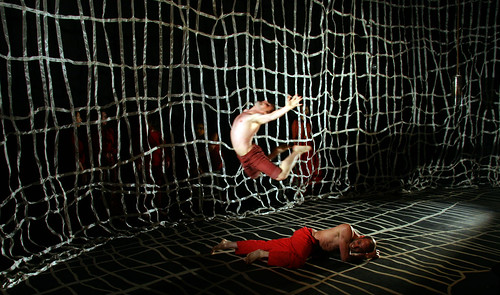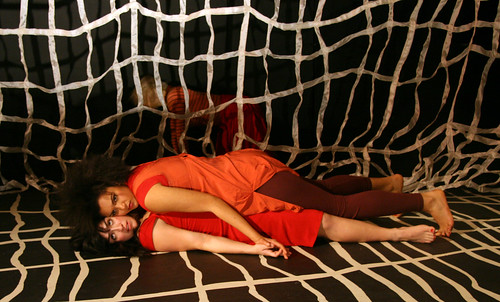Music soars in Cutting Ball’s Tontlawald
Ensemble members (top) Sam Gibbs and (bottom) Wiley Naman Strasser frolic in an energetic pas de deux in Cutting Ball's world premiere of Tontlawald, a fairy tale told in music, dance and text. Below: A duplicate version of Lona (Marilet Martinez, bottom) is made (Rebecca Frank, top) while Lona's cruel stepmother (Madeline H.D. Brown, rear) waits for the girl back in the village. Photos by Annie Paladino
Darkness. Voices. Chanting. Then drumming and clapping.
The opening of Cutting Ball Theater's Tontlawald is electrifying. The sheer power of joined voices, unamplified, is undeniable and extraordinarily beautiful.
In John Bischoff's stunning arrangements, the vocal music in this world-premiere production emerges as the star of the show. Performed by the seven-member ensemble, the music, which ranges from Sarah Hopkins' "Aboriginal Song" to a delicious slice of Mozart's The Magic Flute to doo-wop and barbershop quartet sounds, is reason enough to see this fitfully engaging, ultimately disappointing exercise in experimental storytelling.
The experiment is telling an Estonian fairy tale compiled by Andrew Lang in his 1901 The Violet Fairy Book about a ghost forest, where an abused girl named Lona goes to escape the torture of her stepmother and eventually seek vengeance against her. Co-directors Paige Rogers and Annie Paladino and choreographer Laura Arrington combine vocal music, dance and text fragments by Cutting Ball's resident playwright, Eugenie Chan, to tell the story in bits and pieces.
At only just over an hour, the piece is brief but still has too many moments that fail to engage. That's a shame because there are so many interesting elements here, most notably the music. Production designer Silvie Deutsch, working with lighting designer David Sinaiko, creates an intriguing play space – a mostly empty black box surrounded by a papery web representing, I suppose, the ghost forest and its influence.
Visually and sonically, Tontlawald reaches some captivating heights, but Arrington's choreography emerges as the most disappointing element in the mix. Except for an electrifying pas de deux performed by Sam Gibbs and Wiley Naman Strasser, two wild boys frolicking in the forest, the movement doesn't have nearly the impact of the music, the visual design or the text. There's a lack of detail to the work that clouds the intent of the performers, and any emotion generated by the music tends to dissipate in the dance.
At its best, Tontlawald feels mysterious and shot through with the sound of sadness and of joyful beauty – as when the music and the story pieces combine to create a sense of character and situation (especially whenever Cindy Im's gorgeous voice takes the lead). But at its worst, the show feels like an artsy college project, as when, toward the end, the show practically dies when we're asked to contemplate a tedious stage picture comprising an electric fan, a microphone in a boot and a male dancer. The show simply isn't pushing far enough and meeting its own challenges.
I think if I could only listen to Tontlawald I think I'd like it a whole lot more than I did actually watching it.
FOR MORE INFORMATION
The Cutting Ball Theater's Tontlawald continues through March 11 at EXIT on Taylor, 277 Taylor St., San Francisco. Tickets are $10-$50. Call 415-525-1205 or visit www.cuttingball.com.

